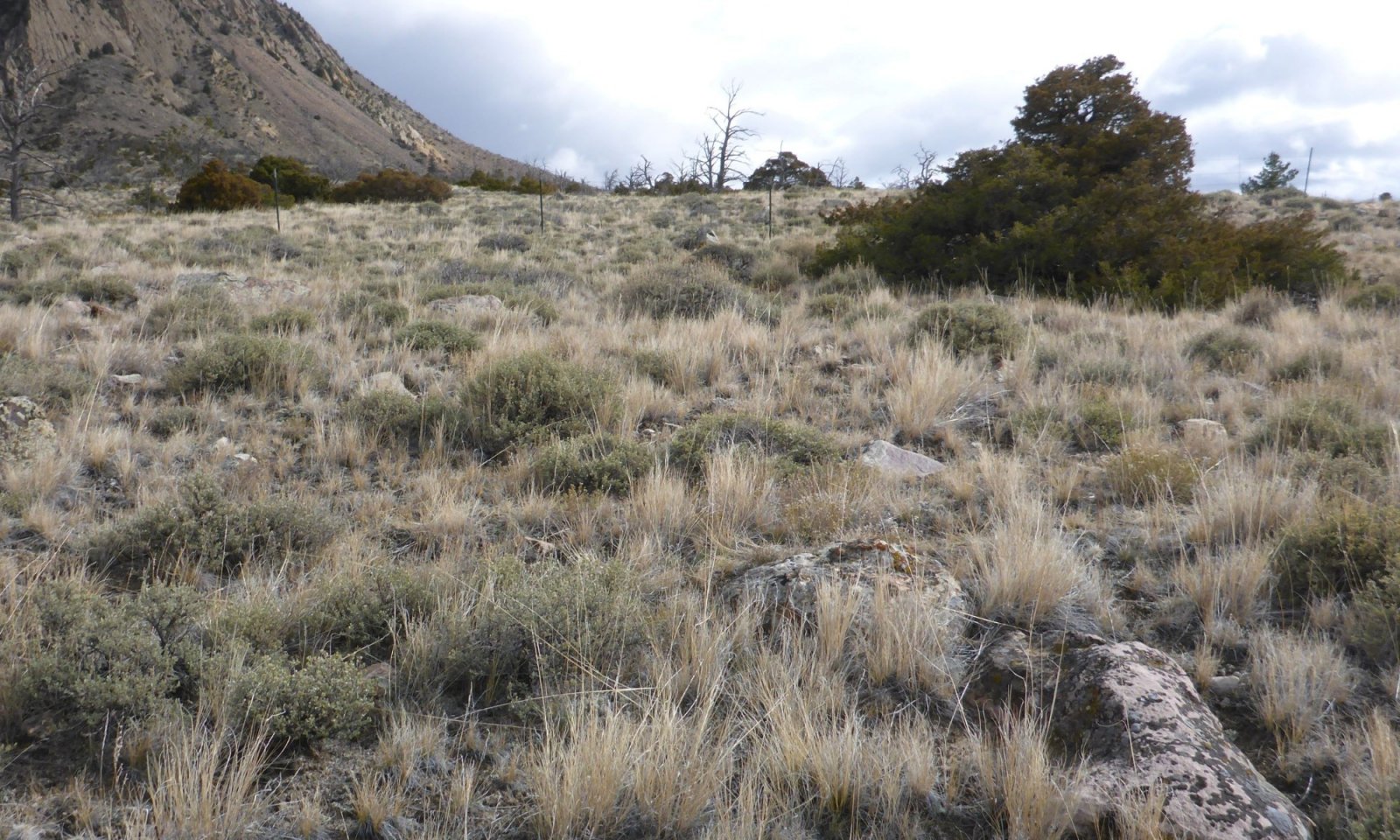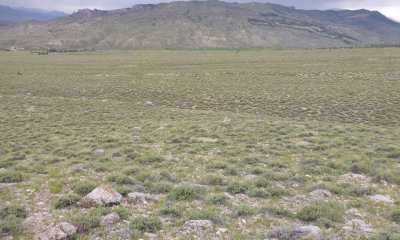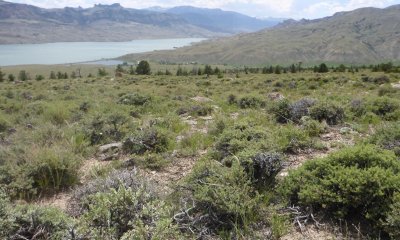
Limy Skeletal (LiSk) Absaroka Lower Foothills
Scenario model
Current ecosystem state
Select a state
Management practices/drivers
Select a transition or restoration pathway
-
Transition T1-2
Frequent and severe grazing (yearlong grazing) or compaction from surface traffic, will weaken the mid-stature grasses and allow threadleaf sedge to increase.
More details -
Transition T1-3
Frequent and severe grazing as well as prolonged drought weakens the herbaceous cover reducing the community to a sagebrush dominated canopy.
More details -
Transition T2-4
Drought with or without hoof impact or mechanical soil impact to displace the sod opens the niche for invasive species to establish.
More details -
Restoration pathway R3-1
Brush management with seeding and long-term prescribed grazing with rest will allow this community to improve.
More details -
Transition T3-4
Disturbance to the soil surface provides the opportunity for invasive species to find their niche in a community.
More details -
Restoration pathway R4-5
Integrated weed management, seeding and grazing management will establish a community similar to Reference.
More details -
Transition T5-4
Any disturbance to or failure in reclaiming the community leaves this State at risk to invasion.
More details -
No transition or restoration pathway between the selected states has been described
Target ecosystem state
Select a state
State 1
Bluebunch Wheatgrass/Sagebrush



Description
The Bluebunch Wheatgrass/Sagebrush State (State 1) is the reference community for the Limy Skeletal ecological site. The prominent cover of bluebunch wheatgrass, king-spike fescue and other mid-stature cool-season bunchgrasses with perennial forbs and a mix of black sagebrush and winterfat make for a productive and stable site.
Characteristics and indicators
Bluebunch wheatgrass is the dominant herbaceous species on this site with black sagebrush as the dominant woody cover. Lichen provide a significant soil cover in combination with other cryptogamic crusts.
Resilience management
The hardiness of the vegetation that thrive within the harsh conditions of the soil characteristics of the Limy Skeletal ecological site create a plant community resistant to change. But once disturbed, the herbaceous component of this site is difficult to restore, reducing the resiliency of the community.
Submodel
Description
The Sod-former/Sagebrush ecological site is a low-stature community that has shifted from the cools-season bunchgrasses to tillering grass-likes (threadleaf sedge). Fringed sagewort and pricklypear cactus are common.
Characteristics and indicators
Black sagebrush is still the prominent woody cover, however there may be a notable composition of winterfat. Season of use and species of grazing ungulate will be a factor affecting this cover. The sagebrush cover is still dwarfed or droughty in appearance and generally has been reduced in vigor by the shift in hydrology of this community. Most other mid and short-stature cool-season bunchgrasses are limited to within the canopy of the sagebrush or within the protective cactus clumps.
Resilience management
The dense root map of threadleaf sedge makes this community extremely resistant to change, and resilient to disturbance. Although the establishment of threadleaf sedge is a slow process, it will recover with time.
Removal of grazing or disturbance does not provide a shift in the herbaceous cover within this community. The overall health and vigor of both the herbaceous as well as woody cover will improve with the removal of the grazing pressure or disturbance from the community.
Submodel
Description
The loss of most of the herbaceous understory in the community leaves a barren and generally decadent (in appearance) stand of black sagebrush, with rubber rabbitbrush in some areas. Lichen and cryptogramic crust cover may or may not be in tact, health of this living soil cover is dependent on the type of disturbance and period of recovery following the disturbances that has lapsed.
Characteristics and indicators
The dominance of sagebrush cover and the lack of most herbaceous cover is the indication of the Sagebrush/Bare Ground State. Remnant populations of perennial grasses will occur in the canopy of sagebrush or within the protective niche within cactus clumps.
Resilience management
The lack of native propagates and the limitations of this calcic soil restrict the ability of most native species to recover, lowering the resiliency of this State. This ecological state is at risk of transitioning to an invaded state due to the lack of soil cover and competitive native species.
Submodel
Description
The Invaded State has a range of variability that is distinguished by its population of invasive or introduced (non-native) species that has successful established and become significant within the composition of the community. A significant component of this community initially is native species common to the Limy Skeletal ecological site.
Characteristics and indicators
The composition by weight of ten percent or more of an invasive species is the factor tipping a community over the threshold into the Invaded State. The community can be relatively intact, having a representative composition of native species similar to the Reference State, but with a significant composition (minimum of five percent) cover of an invasive species or mix of invasive species. Cheatgrass is the most significant threat at this time; however, there are other aggressive non-native species that pose a concern on this ecological site. These species include field cottonrose, mustards, Russian thistle, and Kochia.
Resilience management
The competitive edge of most invasive species makes this site resistant to change and resilient following disturbance. Cheatgrass has been seen to respond with a positive potential following disturbances (fire, mechanical).
Submodel
Description
The Degraded State could be drafted as a stand-alone box within the state and transition model diagram. No matter what state a site originally is ranked in, once the site is mechanically disturbed, or suffers a catastrophic or significant natural disaster that alters the soil properties (erosional, depositional, hydrological or chemical), the site potential is altered.
Mechanical disturbances and reclamation practices using non-native species could qualify some stages of this state to be considered as a land use shift. The end result in either case is the shift in potential and response in management so that it is no longer similar to the reference community. The potential shifts are highly variable, so a dynamic state was captured to highlight the altered communities that exist on the landscape.
Characteristics and indicators
The soil disturbance and mechanical or physical removal of the vegetative canopy is the key characteristic of the Disturbed State. The initial indicators are the primary successional species that establish following a disturbance including kochia, six weeks fescue, and sunflowers. These initial colonizers will then be followed by any seeded species, or other species from within the locations seed bank.
Resilience management
The Disturbed State is highly variable and in a state of flux as the successional processes occur. Continued disturbance of these communities is a potential threat; and the communities are at high risk of transitioning to the Invaded State.
Submodel
Mechanism
Frequent and severe (year-long or continuous season-long ) grazing or compaction from surface traffic, will convert the plant community to a Threadleaf Sedge Sod Plant Community. The impact to of frequent or repeated hits during grazing, hoof impact, and lack of rest for recovery weakens and removes the key grass species in the community. As the mid-stature grasses decline, threadleaf sedge is able to increase and alter the hydrology of the site.
Constraints to recovery
The dense root mat formed by threadleaf sedge alters the hydrology, effectively removing moisture from the site, limiting the available resources for other native species. The dense sod also limits the available soil space for seedling establishment. Interpspaces between sod patches are prone to erosion and runoff (limited infiltration of moisture).
Mechanism
Frequent and severe grazing plus no fire on soils with limited soluble salts, will convert the plant community to the Sagebrush/Bare Ground Plant Community. This is especially evident on areas with historically higher precipitation and the sagebrush stand is not adversely impacted by drought or heavy browsing. Grazing impacts to the herbaceous cover repeatedly removes it from the community leaving a sagebrush dominated community. Drought, insect damage, and other natural disturbances can assist in this transition.
Constraints to recovery
The lack of a seed bank and the harsh environment of the soils limits seedling establishment and survival. The unpredictable and variable spring precipitation also limits success of recovery for the Limy Skeletal ecological site.
Mechanism
Drought, Frequent or severe grazing, Disturbance – Drought as the only factor or drought with grazing intensity together can work to weaken or kill Wyoming big sagebrush on the landscape, and once it has declined or been removed from an area it is not known if or how long it will take for it to come back without cultural methods, which do not carry a reliable success rate. Threadleaf sedge have been seen to die back or die out with prolonged drought opening the canopy and the community’s vulnerability to invasive species. Disturbance by mechanical means or human activities that break the root masses or disturb the soil surface open this closed community to potential invasive species, especially when there is a readily available seed source for those invasive species.
Constraints to recovery
The dense sod of threadleaf sedge will continue to impact the hydrology and competition for limited resources in this community limiting the potential for recovery. The lack of other key herbaceous species also is a constraint on this site. The inability, at this time, to eradicate cheatgrass does not allow for a complete recovery of an invaded community.
Mechanism
Brush management with prescribed grazing or rest allows for this community to improve. Trials completed in the local area have demonstrated the ability for these Limy Skeletal ecological sites to recover herbaceous cover following a sagebrush mowing treatment. The recovery is dependent on the remnant population the is present, the current weather patterns, and timing.
Relevant conservation practices
| Practice | External resources |
|---|---|
|
Brush Management |
|
|
Prescribed Burning |
|
|
Critical Area Planting |
|
|
Mulching |
|
|
Prescribed Grazing |
|
|
Grazing Land Mechanical Treatment |
|
|
Range Planting |
|
|
Heavy Use Area Protection |
|
|
Integrated Pest Management (IPM) |
Mechanism
Drought, soil disturbances, or high-intensity grazing with a seed source present can open the soil surface and weaken the sod allowing invasive species to establish. Although not common, fire can provide the niche for cheatgrass to establish on this site.
Constraints to recovery
Once invasive species, especially cheatgrass, establish, it is costly and difficult (if even possible) to remove. The lack of the key grass species also limits recover of this site.
Mechanism
Integrated Pest Management, with Seeding the site to a native mixture - Success is not known to have occurred, and is rated to be low and highly variable for the rate of control of most species. Cheatgrass is one of the most invasive species for many of these sites, although there are other challenges. With intensive weed control and inputs this community can resemble an at-risk community within the reference state, but it is not possible to reach the reference community condition once annuals have established on a site.
Relevant conservation practices
| Practice | External resources |
|---|---|
|
Critical Area Planting |
|
|
Prescribed Grazing |
|
|
Grazing Land Mechanical Treatment |
|
|
Range Planting |
|
|
Heavy Use Area Protection |
|
|
Integrated Pest Management (IPM) |
|
|
Upland Wildlife Habitat Management |
Mechanism
Frequent or Severe Grazing, Disturbance with a seed Source, or Drought - Any disturbance that occurs or stress that is placed on the herbaceous cover, weakens the canopy and allows for invasive species to establish if a seed source is present. This State is at high risk of transitioning to an Invaded State. The challenge of successful seedings on a calcareous soil opens the community to invasion.
Constraints to recovery
The challenge of eradicating or reducing invasive species such as cheatgrass prevents recovery of most invaded communities without significant inputs for weed control, seeding with long-term grazing management.
Model keys
Briefcase
Add ecological sites and Major Land Resource Areas to your briefcase by clicking on the briefcase (![]() ) icon wherever it occurs. Drag and drop items to reorder. Cookies are used to store briefcase items between browsing sessions. Because of this, the number of items that can be added to your briefcase is limited, and briefcase items added on one device and browser cannot be accessed from another device or browser. Users who do not wish to place cookies on their devices should not use the briefcase tool. Briefcase cookies serve no other purpose than described here and are deleted whenever browsing history is cleared.
) icon wherever it occurs. Drag and drop items to reorder. Cookies are used to store briefcase items between browsing sessions. Because of this, the number of items that can be added to your briefcase is limited, and briefcase items added on one device and browser cannot be accessed from another device or browser. Users who do not wish to place cookies on their devices should not use the briefcase tool. Briefcase cookies serve no other purpose than described here and are deleted whenever browsing history is cleared.
Ecological sites
Major Land Resource Areas
The Ecosystem Dynamics Interpretive Tool is an information system framework developed by the USDA-ARS Jornada Experimental Range, USDA Natural Resources Conservation Service, and New Mexico State University.




